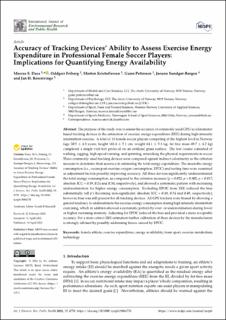| dc.contributor.author | Friborg, Oddgeir | |
| dc.contributor.author | Kristoffersen, Morten | |
| dc.contributor.author | Pettersen, Gunn | |
| dc.contributor.author | Sundgot-Borgen, Jorunn | |
| dc.contributor.author | Dasa, Marcus Småvik Tutu | |
| dc.contributor.author | Rosenvinge, Jan H. | |
| dc.date.accessioned | 2022-08-04T08:35:31Z | |
| dc.date.available | 2022-08-04T08:35:31Z | |
| dc.date.created | 2022-04-29T10:12:55Z | |
| dc.date.issued | 2022 | |
| dc.identifier.citation | International Journal of Environmental Research and Public Health. 2022, 19(8), Artikkel 4770. | en_US |
| dc.identifier.issn | 1661-7827 | |
| dc.identifier.uri | https://hdl.handle.net/11250/3010082 | |
| dc.description | This is an open access article distributed under the Creative Commons Attribution License which permits unrestricted use, distribution, and reproduction in any medium, provided the original work is properly cited. | en_US |
| dc.description.abstract | The purpose of the study was to assess the accuracy of commonly used GPS/accelerometer-based tracking devices in the estimation of exercise energy expenditure (EEE) during high-intensity intermittent exercise. A total of 13 female soccer players competing at the highest level in Norway (age 20.5 ± 4.3 years; height 168.4 ± 5.1 cm; weight 64.1 ± 5.3 kg; fat free mass 49.7 ± 4.2 kg) completed a single visit test protocol on an artificial grass surface. The test course consisted of walking, jogging, high-speed running, and sprinting, mimicking the physical requirements in soccer. Three commonly used tracking devices were compared against indirect calorimetry as the criterion measure to determine their accuracy in estimating the total energy expenditure. The anaerobic energy consumption (i.e., excess post-exercise oxygen consumption, EPOC) and resting time were examined as adjustment factors possibly improving accuracy. All three devices significantly underestimated the total energy consumption, as compared to the criterion measure (p = 0.022, p = 0.002, p = 0.017; absolute ICC = 0.39, 0.24 and 0.30, respectively), and showed a systematic pattern with increasing underestimation for higher energy consumption. Excluding EPOC from EEE reduced the bias substantially (all p’s becoming non-significant; absolute ICC = 0.49, 0.54 and 0.49, respectively); however, bias was still present for all tracking devices. All GPS trackers were biased by showing a general tendency to underestimate the exercise energy consumption during high intensity intermittent exercising, which in addition showed a systematic pattern by over- or underestimation during lower or higher exercising intensity. Adjusting for EPOC reduced the bias and provided a more acceptable accuracy. For a more correct EEE estimation further calibration of these devices by the manufacturers is strongly advised by possibly addressing biases caused by EPOC. | en_US |
| dc.language.iso | eng | en_US |
| dc.subject | energy availability | en_US |
| dc.subject | exercise expenditure | en_US |
| dc.subject | exercise metabolism | en_US |
| dc.subject | female athlete | en_US |
| dc.subject | team sport | en_US |
| dc.subject | technology | en_US |
| dc.title | Accuracy of tracking devices’ ability to assess exercise energy expenditure in professional female soccer players: Implications for quantifying energy availability | en_US |
| dc.type | Peer reviewed | en_US |
| dc.type | Journal article | en_US |
| dc.description.version | publishedVersion | en_US |
| dc.rights.holder | © 2022 by the authors | en_US |
| dc.source.pagenumber | 11 | en_US |
| dc.source.volume | 19 | en_US |
| dc.source.journal | International Journal of Environmental Research and Public Health | en_US |
| dc.source.issue | 8 | en_US |
| dc.identifier.doi | 10.3390/ijerph19084770 | |
| dc.identifier.cristin | 2020024 | |
| dc.description.localcode | Institutt for idrettsmedisinske fag / Department of Sports Medicine | en_US |
| dc.source.articlenumber | 4770 | en_US |
| cristin.ispublished | true | |
| cristin.fulltext | original | |
| cristin.qualitycode | 1 | |
